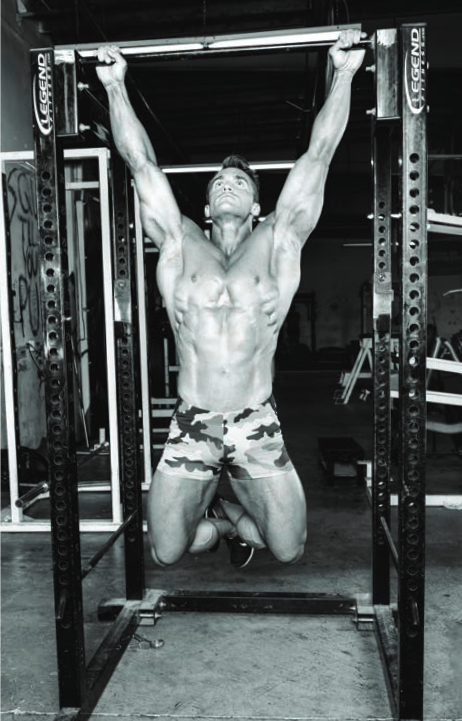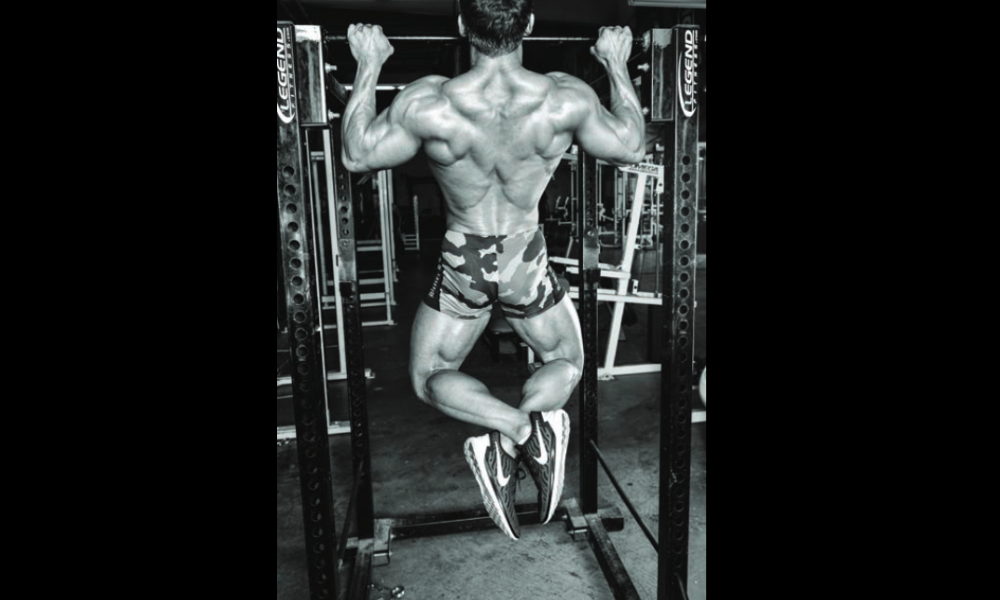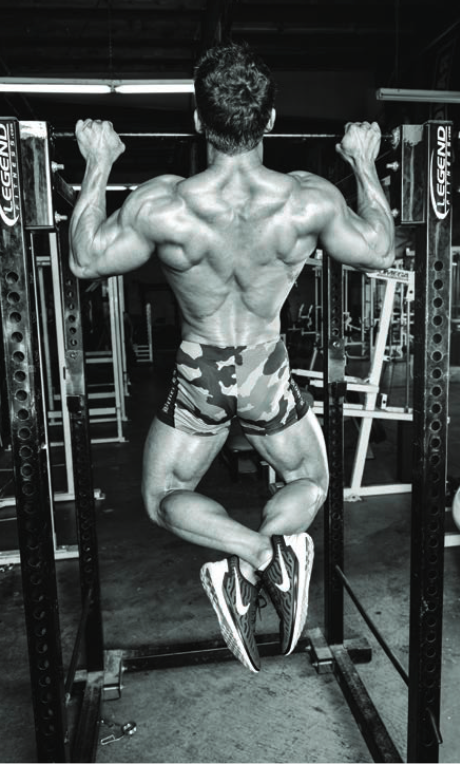Improve speed, power, and neuro drive with this exercise
created by a foremost authority in spinal biomechanics.
In May of 2013, I met Dr. Stuart McGill, who, in short, saved my athletic career. I had a badly damaged back and was on the way out of elite powerlifting. He helped me start from ground zero, rebuild back to 100 percent, and in the process taught me what being a true athlete is. McGill not only helped me regain my lower-back athleticism and become pain free, he also taught me how to get more bang for my buck with newer and better versions of exercise that I’d been doing for decades. In short, he taught me to critically think before I did anything in the gym, period. Once I was able to start training hard again, I went back to Ontario, Canada, for a follow-up with Dr. McGill. This was the session where I learned the McGill pull-up (my name for it, not his). In

short, these are pull-ups performed with 100 percent effort, as a way to generate maximum neuro drive. They have become one of the best ways I know to improve back strength and overall development while minimizing injury. Doing sets of 10 pull-ups at a bodyweight of 250-plus pounds can be risky for the tendons of your pecs, lats, and biceps. Fatigue is typically the culprit with these types of injuries. What McGill advocates are sets of one or two reps at a time, but with maximum force and explosion with each and every rep. The problem with doing multiple reps at a time in a traditional manner is you can’t exert 100 percent effort and force with sets of five, seven, or 10. You might start off at 100 percent, but you’ll end up closer to 50 percent as you close in on failure.
McGill has seen tremendous improvements in athletes’ ability to do reps on the
pull-up in as little as one month. If you’re a tactical athlete (law enforcement, military, firefighter, etc.) who is tested on your pull-up count, this is a good way to build your pull-up volume and have it ready for test days when you need it. For those who aren’t tested on their pull-ups, it’s a great way to add high-quality volume to the movement. I’m currently at about 20 sets of one rep at this point, and I feel great. I usually do these anywhere from two to three times per week as part of my warm-up. I feel that these wake my body and my brain for the work that’s to come on the particular training day, and I feel that I have become faster and more explosive overall. On dead lift day, I start by using them as a warm-up and then I do 10 to 20 singles after my main deadlift work is done. I feel it’s been huge for my trap, rhomboid, and lat development, especially coming off a serious injury where I couldn’t train hard for two years. This efficient training helped make up for lost time.
1
This exercise is to be performed for one to two reps at a time. Each rep is for maximum effort, focus, and speed. Every rep should be perfect, never rushed. Do not try this for sets of five to 10. This is meant for perfect singles.
2
Use a “lobster claw” grip. I’ve found that this greatly enhances my power with every other compound movement. After wrapping your fingers around the bar, cover your forefinger with your thumb and lock it down tightly (this is kind of like a reverse hook grip). Grip is the start of any truly powerful contraction. It doesn’t matter how strong your muscles are if you have no grip to control the weight.
3
Grab the bar with your lobster claw and hang until motionless; retract your shoulder blades and squeeze as hard as you can. Once you’re tight from head to toe and your body is stiff, explode upward and violently pull your body to the bar. Contract as hard as you can at the top for a second or so, then gently lower yourself back down to the floor.
4
After returning to the floor, rest for 10 to 20 seconds. Tilt your head back, take a deep breath, and let your arms swing freely. Focus on the other reps to come and how you can make them better and faster.
5
Start with six to eight total reps and progress to more each workout. Stop when your speed begins to degrade and you have to start cheating. Everything should be controlled and methodical, not sloppy like a fish out of water
6
This is not a kipping pull-up. Yes, you want to generate power, but specifically in the muscle of the back. There is no leg momentum whatsoever. This is a strict and 100 percent pure and legit pull-up.
7
McGill pull-ups are for the advanced lifter who can do 20 or more proper singles in less than seven minutes without losing speed. I understand some will not be able to keep up the speed, power, and endurance to do these properly right away. For those who aren’t ready to do explosive unassisted reps, I suggest that you either have help from a training partner, or use an elastic band to assist you. Those who are very advanced can hang chains around your neck to make the lift more challenging.


 short, these are pull-ups performed with 100 percent effort, as a way to generate maximum neuro drive. They have become one of the best ways I know to improve back strength and overall development while minimizing injury. Doing sets of 10 pull-ups at a bodyweight of 250-plus pounds can be risky for the tendons of your pecs, lats, and biceps. Fatigue is typically the culprit with these types of injuries. What McGill advocates are sets of one or two reps at a time, but with maximum force and explosion with each and every rep. The problem with doing multiple reps at a time in a traditional manner is you can’t exert 100 percent effort and force with sets of five, seven, or 10. You might start off at 100 percent, but you’ll end up closer to 50 percent as you close in on failure.
short, these are pull-ups performed with 100 percent effort, as a way to generate maximum neuro drive. They have become one of the best ways I know to improve back strength and overall development while minimizing injury. Doing sets of 10 pull-ups at a bodyweight of 250-plus pounds can be risky for the tendons of your pecs, lats, and biceps. Fatigue is typically the culprit with these types of injuries. What McGill advocates are sets of one or two reps at a time, but with maximum force and explosion with each and every rep. The problem with doing multiple reps at a time in a traditional manner is you can’t exert 100 percent effort and force with sets of five, seven, or 10. You might start off at 100 percent, but you’ll end up closer to 50 percent as you close in on failure.






















You must be logged in to post a comment Login